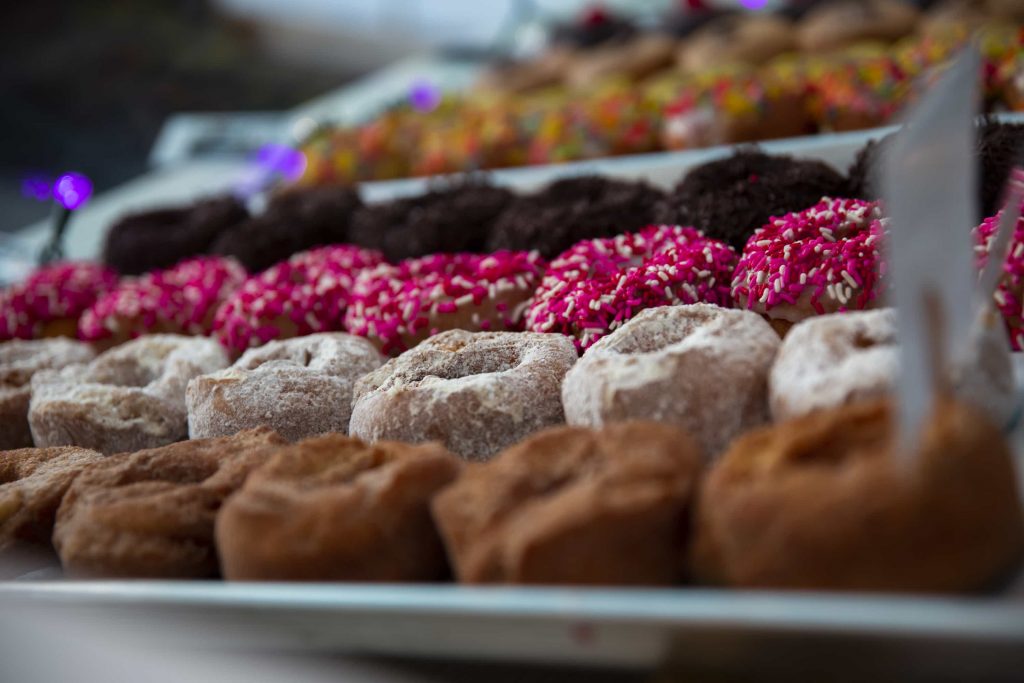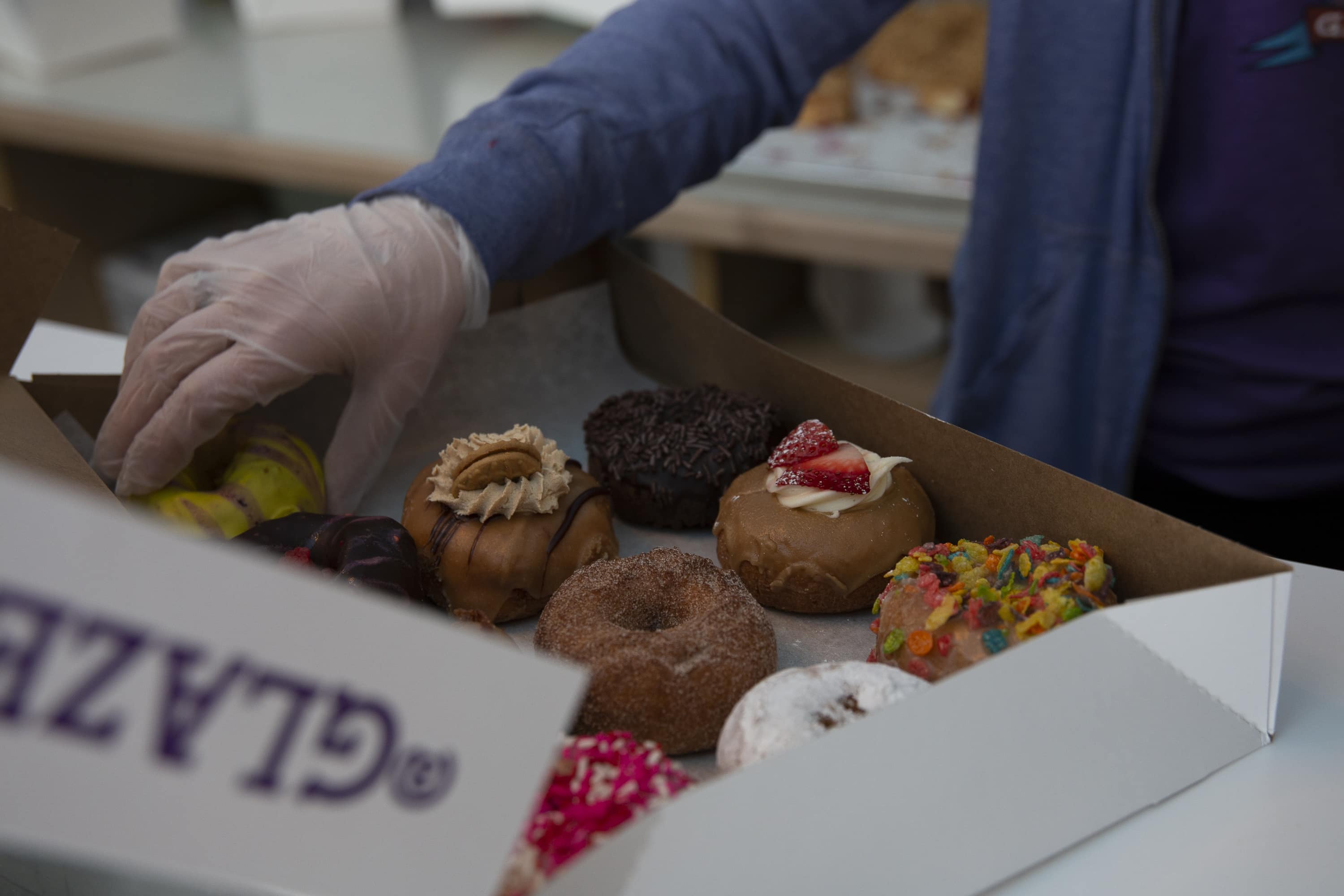The Insta_merican Doughnut
Insta_merican Doughnut

Cartoon doughnuts with outlandish mustaches, colorful hats and whimsical facial expressions greet customers who walk through Glazed & Confused’s eye-catching purple doorway.
“We designed our store to be the apex of fun,” says Paul Valenti, the shop’s owner who describes the design aesthetic as “graffiti meets corporate.” Paul, along with his wife, Sarah and their two children, Izabella and Roman, are the heart and soul of the doughnut operation that has been taking the Syracuse community by storm since 2016.
The brain-child of Izabella and Roman, who envisioned a pastry shop similar to one the family would visit during vacations in Rehoboth Beach, Delaware, Glazed & Confused ’s rapid rise as a Salt City staple has propelled the family and their wonderfully unconventional pastries to a level of popularity that’s exceeded even their wildest expectations.
Doughnuts are a versatile food that have become increasingly popular. 202.8 million Americans consumed doughnuts in 2018, up from the 194.64 million reported in 2017, according to data specialists at Statista. Their evolution stems from a complicated history— the French, Russians, and Native Americans all claim to have a stake in their origin. However, the first documented doughnuts in America were Dutch imports from settlers who brought their “olykoeks,” (translation: oily cakes) to New York, then New Amsterdam, in the 1600s. A more formal introduction to doughnuts was subsequently presented in the 1809 domestic manual, The Frugal Housewife, as a “Dough Nut” recipe prompted homemakers to try their hand at fried desserts.
Since then, doughnuts have fallen into a limbo of abstract labels and convoluted interpretations: a dessert that’s been baked, fried, torched and topped with a garnish of bacon bits to the point of near-unrecognizable lunacy. The word itself, has been shortened into slang by mass-distribution food conglomerates for public convenience. Yet, doughnuts remain some of the most iconic emblems of classic Americana sentiment.
“Doughnuts are symbols of bodily desire and America, both of which figure at heart much of our popular cultural representations of ourselves,” says Dr. Paul R. Mullins, a historical archaeologist and author of Glazed America: A History of the Doughnut. “Homer Simpson responds to desires we all have and wish we could answer to as well. Lots of people overseas see doughnuts as symbols of American foodways, and of course they are good examples of the high carbohydrate, sugar-rich, rapidly consumed foods that are at the heart of American foodways.”
This richness is translated into glossy, hyper-filtered online images that garner hundreds and even hundreds of thousands of likes on social media platforms. The doughnut’s digital age makeover has made them an unlikely object of foodie fan-fare, with social media users flocking to snap pictures of the edible creations, hoping to provoke digital envy.
“If it wasn’t for Instagram I don’t know if we would be here today,” said Leslie Polizzotto, co-founder of The Doughnut Project. In New York City, Polizzotto’s “project,” has grown a cult-following and massive success with its uncanny flavors and aesthetically pleasing culinary presentations.
A former full-time lawyer, Polizzotto, along with her business partner Troy Neal, envisioned a pastry shop that would celebrate unexpected and unorthodox flavor marriages. The pair, who have successfully opened two locations in Manhattan, are known for using unmatched, restaurant quality ingredients like its house-made blackberry jam and even a bone marrow-infused chocolate pastry cream. Much-loved menu standouts include a vibrant beet and ricotta doughnut inspired by a savory beet salad and a distinct olive oil black pepper doughnut simulating fresh bread dipped in warm olive oil.

It wasn’t long after Polizzotto and Neal opened their first story that their social media presence grew astronomically. “When we started, we had 700 followers and today we have 105,000 followers — all organic. Every day we have people come in our shop from Australia, Japan, England, Scotland, China — you name it,“ said Polizzotto.
One of the bakery’s most popular niches is its collaborations with alcohol brands like Angry Orchard, Patron and Campari. Through experimentation and hours — sometimes days — of taste tests, the bakery coats fluffy pastries in sinfully sweet, liquor-infused glazes containing an alcohol content in line with FDA guidelines. Eventually, even non-food companies like Adidas and Crayola took notice of the store’s quickly-growing digital popularity and began requesting their own “projects.” Through collaboration, the shop is able to translate their clients’ brand identity into specialty pastries, such as a recent collection of doughnuts glazed in Valspar paint-inspired icing hues including “mink gray” and “warm buff.”
But doughnut shop owners aren’t the only ones reaping the perks of food-driven social media popularity. In sunny Southern California, Ilya Albert fastens a comically large top hat to his head and buttons up a doughnut emblazoned shirt to transform into his internet persona, “The Duke of Donuts.”
To his friends, the 30-year-old digital content coordinator at the University of Southern California is a film lover with a penchant for lavish vernacular and all things doughnut-related. In his Instagram bio, the fictional pastry nobleman proudly proclaims himself, “the cat-in-the-hat, with donuts,” and spends his spare time traveling to local and even national doughnut shops, giving out noble seals-of-approval to these humble establishments.
“Whenever I’ve been to doughnut shops dressed up in the character, people would automatically say, ‘Who’s that in the hat? Oh, that’s the duke,’” said Albert, 30.
His over 3500 Instagram followers, whom he affectionately refers to as “donuts and donettes,” include a growing list of California doughnut shop owners like actor Danny Trejo, who opened Trejo’s Coffee & Donuts in Los Angeles last year. For, Albert, who hails from a family of Russian immigrants that relocated to Sacramento, doughnuts illicit childhood nostalgia. He fondly remembers visiting doughnut shops with his grandparents, who would order fresh doughnuts along with coffee for themselves and chocolate milk for their young grandson. He’s also fascinated by the multiple international doughnut incarnations, from the Israeli Sufganiyah and Armenian Ponchiks to Mexican Churros and Russian Pishki — pastries all with fried dough foundations. “I found it interesting that numerous cultures have their own versions, and anywhere you go it can be a common discussion,“ he said.
Self-professed food lovers like The Duke of Donuts use Instagram to document their doughnut discoveries and share their findings with mass networks of fellow culinary aficionados.
“Everyone is as sweet as the content that we talk about,” said Albert, who has made several “doughnut friends” through his Instagram.
In Salt Lake City, Utah, Benjamin Lee uses the Instagram pseudonym @donutcritic to promote his love for doughnuts while reaching over 2500 followers. When he’s not at his day job as an Adobe project manager, the 37-year-old father of two seeks out the newest doughnut digs around Salt Lake as well as when traveling with his family.
“People are waking up and treating doughnuts as a medium and being able to go in multiple directions with them,” says Lee who cites a blow-torched, sugar-crystallized pina colada donut from Hollywood’s Gastro Garage as the most unconventional form of the pastry he’s seen. “There are bigger shops like Krispy Kreme and I feel like they serve a purpose because some people just want really consistent, convenient doughnuts,” he adds. “I’ve always felt like that’s a doughnut of necessity.”
In their Syracuse shop, the Valenti family is serving the freshest desserts to ensure their customers receive the best experience possible.
“We make doughnuts every 10 minutes all day long, so you never get a doughnut that’s over 30 minutes old,” says Paul.
Recent famous walk-ins like singer Sam Smith, WWE stars the Bella Twins, and most recently, Patriots tight end Rob Gronkowski, have also ensured the business’s serious social clout. Nearing 32 thousand Instagram followers and with plans to expand to Rochester and Saratoga Springs in the upcoming year, it won’t be long until other Upstate New Yorkers will be able to experience the Glazed & Confused hype for themselves. Though the Valentis haven’t forgotten their humble roots and original business ethos.
“I like to think that the Syracuse community is good to us because they realize we’re good to them,” says Paul, who instilled the decree that the shop would donate 10% of its profits to a local charity and continues to do so. With plans to unveil new Keto doughnuts in addition to serving gluten-free pastries on Wednesdays and Saturdays, the business is making sure to cater to every niche eater.
Though mass-produced doughnut brands like Krispy Kreme and Tim Horton’s are indeed cashing in on their own niche: convenience. Last year, Dunkin’ brands reported $900 million in sales for Dunkin’ Donuts as well as 313 new storefronts across the United States. In 2015, Dunkin’ Donuts even introduced its own version of French pastry guru Dominique Ansel’s highly coveted croissant doughnut hybrid: the cronut.
“We have seen a resurgence from what we thought a doughnut was to what really a doughnut is,” says Thomas Vaccaro, who currently serves as the Culinary Institute of America’s school of baking and pastry arts dean in New York City and has had a 40-year long career as an award-winning pastry chef and baker. “We’ve gotten away from packaged doughnuts that sit on a shelf for three weeks to going to a bakery or café to purchase yeast-raised doughnuts made fresh that day.”
At the Culinary Institute of America, Vaccaro is teaching his students the fundamentals in creating delicious desserts and mouth-watering baked goods — including doughnuts. He notes that several of his students have graduated and gone on to open highly successful small bakeries and pastry shops, catering to the current popularity in freshly baked goods. “I think that people, in all foods, are looking for the best ingredients, the most satisfying for what they’re purchasing, the best value for what they’re purchasing, and will pay for good quality,” he says.
Under layers of lemon zest, matcha dust, and sea salt caramel drizzle, doughnuts remain, at their purest, a simple delicacy that unites people, creating a bond stronger than even the thickest glaze. The internet has undeniably transformed the classically nostalgic dessert into an iteration which appeals to a rising generation of foodies and serial Yelpers. At the same time, these consumers speak to America’s changing tastes: a new era in which diners are welcoming more complex flavor profiles and seeking higher quality from their food. Doughnuts may be the latest treat swept up in a food-vamping bubble, but as their history indicates, they can stand the test of time.
“They have been an American delicacy for over 100 years,” says Albert. “It’s been such a continuous tradition I don’t think we’ll ever let go of it.”





